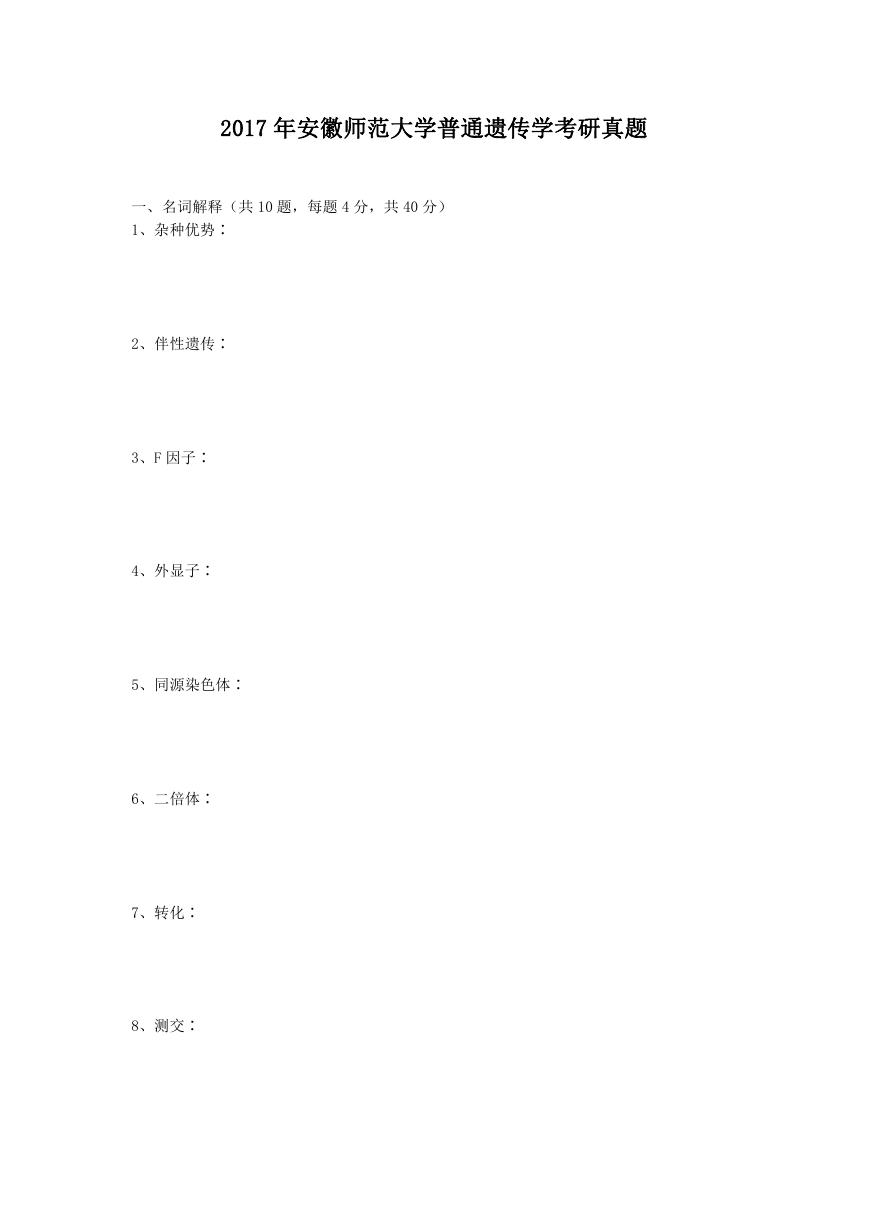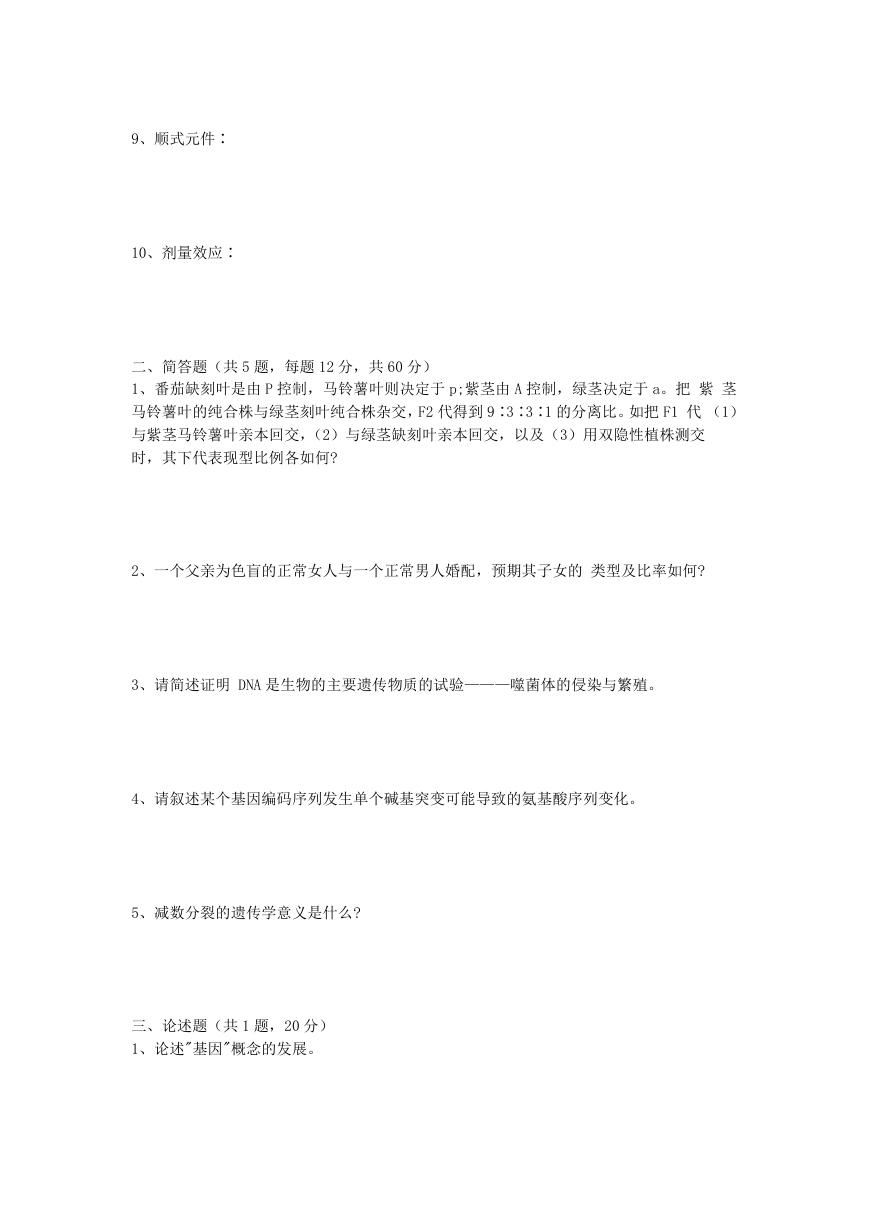2017 年安徽师范大学普通遗传学考研真题
一、名词解释(共 10 题,每题 4 分,共 40 分)
1、杂种优势∶
2、伴性遗传∶
3、F 因子∶
4、外显子∶
5、同源染色体∶
6、二倍体∶
7、转化∶
8、测交∶
�
9、顺式元件∶
10、剂量效应∶
二、简答题(共 5 题,每题 12 分,共 60 分)
1、番茄缺刻叶是由 P 控制,马铃薯叶则决定于 p;紫茎由 A 控制,绿茎决定于 a。把 紫 茎
马铃薯叶的纯合株与绿茎刻叶纯合株杂交,F2 代得到 9∶3∶3∶1 的分离比。如把 F1 代 (1)
与紫茎马铃薯叶亲本回交,(2)与绿茎缺刻叶亲本回交,以及(3)用双隐性植株测交
时,其下代表现型比例各如何?
2、一个父亲为色盲的正常女人与一个正常男人婚配,预期其子女的 类型及比率如何?
3、请简述证明 DNA 是生物的主要遗传物质的试验———噬菌体的侵染与繁殖。
4、请叙述某个基因编码序列发生单个碱基突变可能导致的氨基酸序列变化。
5、减数分裂的遗传学意义是什么?
三、论述题(共 1 题,20 分)
1、论述"基因"概念的发展。
�
四、英译汉(30 分)
The central dogma has also been described as "DNA makes RNA and RNA makes protein,"
origially termed the sequence hypothesis and made as a positive statement by Crick.
However, this simplification does not make it clear that the central dogma as stated
by Crick does not preclude the reverse low of information from RNA to DNA.only ruling
out the flow from protein to RNA or DNA.Crick's use of the word dogma was
unconventional, and has been controversial. The dogma is a framework for
understanding the transfer of sequence information between information-carrying
biopolymers,in the most common or general case,in living organisms. There are 3 major
classes of such biopolymers: DNA and RNA (both nucleic acids).and protein.There are
3×3=9 conceivable direct transfers of information that can occurbetween these. The
dogma classes these into 3 groups of 3:3 general transfers(believed to occur normally
in most cells),3 special transfers(known to occur.but only under specific conditions
in case of some viruses or in a laboratory),and 3unknown transfers (believed never
to occur).The general transfers describe the normal flow of biological information:
DNA can be copied to DNA (DNA replication)DNA information can be copied into mRNA
(transcription)and proteins can be synthesized using the
information in mRNA as a template (translation).
�






 2023年江西萍乡中考道德与法治真题及答案.doc
2023年江西萍乡中考道德与法治真题及答案.doc 2012年重庆南川中考生物真题及答案.doc
2012年重庆南川中考生物真题及答案.doc 2013年江西师范大学地理学综合及文艺理论基础考研真题.doc
2013年江西师范大学地理学综合及文艺理论基础考研真题.doc 2020年四川甘孜小升初语文真题及答案I卷.doc
2020年四川甘孜小升初语文真题及答案I卷.doc 2020年注册岩土工程师专业基础考试真题及答案.doc
2020年注册岩土工程师专业基础考试真题及答案.doc 2023-2024学年福建省厦门市九年级上学期数学月考试题及答案.doc
2023-2024学年福建省厦门市九年级上学期数学月考试题及答案.doc 2021-2022学年辽宁省沈阳市大东区九年级上学期语文期末试题及答案.doc
2021-2022学年辽宁省沈阳市大东区九年级上学期语文期末试题及答案.doc 2022-2023学年北京东城区初三第一学期物理期末试卷及答案.doc
2022-2023学年北京东城区初三第一学期物理期末试卷及答案.doc 2018上半年江西教师资格初中地理学科知识与教学能力真题及答案.doc
2018上半年江西教师资格初中地理学科知识与教学能力真题及答案.doc 2012年河北国家公务员申论考试真题及答案-省级.doc
2012年河北国家公务员申论考试真题及答案-省级.doc 2020-2021学年江苏省扬州市江都区邵樊片九年级上学期数学第一次质量检测试题及答案.doc
2020-2021学年江苏省扬州市江都区邵樊片九年级上学期数学第一次质量检测试题及答案.doc 2022下半年黑龙江教师资格证中学综合素质真题及答案.doc
2022下半年黑龙江教师资格证中学综合素质真题及答案.doc